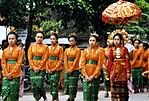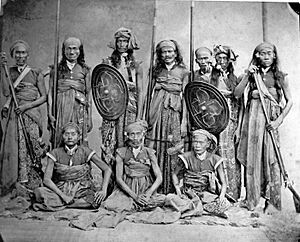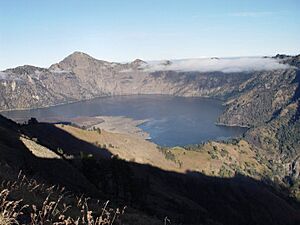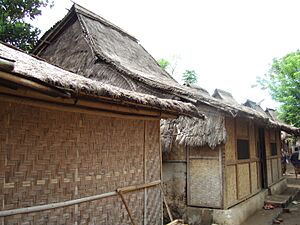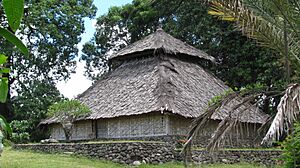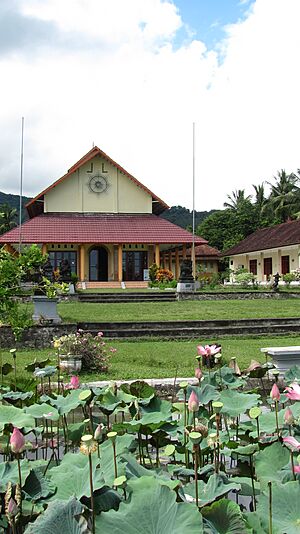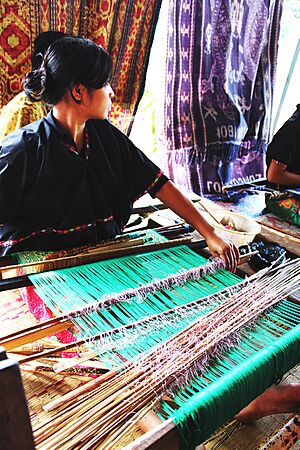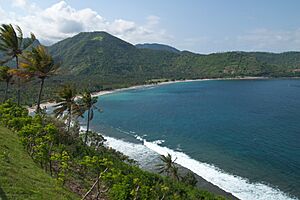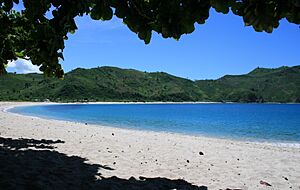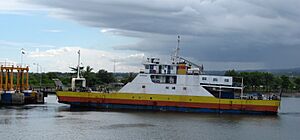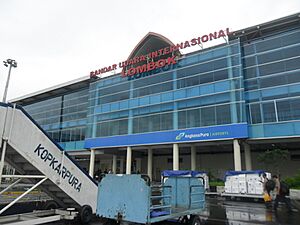Lombok facts for kids
|
Native name:
ᬒᬋᬧᭀᬢ᭄ (Gumi Sasak)
|
|
|---|---|
|
From top, left to right: Tanjung Aan Beach, Sasak wedding, camping over the top of Rinjani, Senggigi beach, Senaru waterfall
|
|
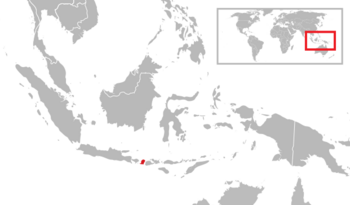
Location (red) of Lombok
|
|
| Geography | |
| Location | Indonesia |
| Coordinates | 8°33′54″S 116°21′04″E / 8.565°S 116.351°E |
| Archipelago | Lesser Sunda Islands |
| Area | 4,607.68 km2 (1,779.04 sq mi) |
| Highest elevation | 3,727 m (12,228 ft) |
| Highest point | Rinjani |
| Administration | |
|
Indonesia
|
|
| Province | West Nusa Tenggara |
| Largest settlement | Mataram (pop. 441,147) |
| Demographics | |
| Demonym | Lombok Islander, Sasak |
| Population | 3,963,842 (mid 2023 estimate) |
| Pop. density | 860.27 /km2 (2,228.09 /sq mi) |
| Ethnic groups | Sasak, Balinese, Mbojo, Chinese-Indonesian, Sumbawa, Flores, Arab, Javanese, Banjarese, Malay, Batak |
Lombok is a beautiful island in Indonesia, part of the West Nusa Tenggara province. It's one of the Lesser Sunda Islands. To its west, the Lombok Strait separates it from Bali. To its east, the Alas Strait lies between Lombok and Sumbawa.
Lombok is shaped like a circle with a "tail" pointing southwest. It's about 70 kilometers (43 miles) wide. The island covers an area of about 4,607 square kilometers (1,779 square miles). This includes some smaller islands nearby. Mataram is the capital city of the province and the largest city on Lombok.
Lombok is similar in size to Bali, its neighbor to the west. They also share some cultural traditions. However, Lombok is part of West Nusa Tenggara province. This province also includes the larger island of Sumbawa to the east. Many smaller islands, known as Gili, surround Lombok.
In mid-2023, about 3.96 million people lived on Lombok. The word Lomboq in the Sasak language means straight or honest.
Contents
How Lombok is Governed
Lombok is managed by the Governor of the West Nusa Tenggara province. The main office for the province is in Mataram, which is in West Lombok.
The island is split into four main areas called kabupaten (regencies) and one kota (city). Each area has its own capital city. Here's a quick look at these areas and how many people live there:
| Name of City or Regency | Capital | Area in km2 |
Pop'n mid 2023 estimate |
|
|---|---|---|---|---|
| West Lombok Regency | Gerung | 922.91 | 753,641 | |
| Central Lombok Regency | Praya | 1,208.39 | 1,099,201 | |
| East Lombok Regency | Selong | 1,605.55 | 1,404,343 | |
| North Lombok Regency | Tanjung | 809.53 | 265,500 | |
| Mataram City | 61.30 | 441,147 | ||
| Total Lombok | 4,607.68 | 3,963,842 |
Lombok's Past
Not much is known about Lombok before the 1600s. The island was made up of many small kingdoms. Each was led by a Sasak 'prince'. These kingdoms often fought with each other. This made it easy for the Balinese people from the west to take control of western Lombok in the early 1600s.
Around the same time, the Makassarese people from Sumbawa took over eastern Lombok. The Dutch first came to Lombok in 1674. The Dutch East India Company made its first agreement with a Sasak princess. By 1750, the Balinese had taken over the whole island. But then, the Balinese kingdoms started fighting among themselves. By 1838, the Mataram kingdom had gained control over the others.
Life for the local Sasak people under Balinese rule was different depending on where they lived. In western Lombok, Sasak and Balinese people often got along well. They even married each other. But in the east, the Balinese kept strong control from their forts. Sasak village leaders became like tax collectors for the Balinese rulers. Many Sasak people lost their land and power.
In 1894, some Sasak leaders asked the Dutch for help against the Balinese. The Dutch sent a large army to Lombok. The Balinese raja (king) gave up, but his younger princes fought back. The Dutch then attacked Mataram and the raja surrendered. By 1895, the entire island became part of the Netherlands East Indies. The Dutch ruled Lombok with a small force. They did this by getting support from both Balinese and Sasak leaders. Many people in Lombok saw the Dutch as helpers who freed them from Balinese rule.
During World War II, Japanese forces took over Lombok in March 1942. They sailed into Ampenan port. The Dutch defenders were quickly defeated. After the war, the Japanese left, and Lombok temporarily returned to Dutch control.
After Indonesia became independent from the Dutch, local leaders still had a lot of power. In 1958, Lombok became part of the West Nusa Tenggara province. Mataram became the provincial capital. During President Suharto's time (1967–1998), Lombok became more stable. However, it didn't grow as fast as Java and Bali. There were food shortages in 1966 and 1973. The government also moved many people out of Lombok to other islands. In the 1980s, tourism started to grow, but local people didn't always get much of the money.
Lombok faced tough times in the late 1990s due to Indonesia's economic problems. Tourism slowed down. But in recent years, it has started to grow again.
Earthquakes in 2018
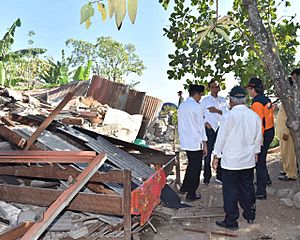
Lombok was hit by several strong earthquakes in 2018. The first one in July killed 20 people and injured many. It also caused a lot of damage. This was a smaller quake before a much bigger one.
On August 5, 2018, a powerful 7.0 magnitude earthquake struck. It caused huge damage in North Lombok. It also affected nearby Bali. More than 550 people died, and over 7,000 were injured. Another earthquake on August 19, 2018, killed 13 people and damaged 1,800 buildings.
At first, Indonesia's disaster agency said they didn't need international help. They believed local people could handle it. However, the help system was not fully ready. So, local police, military, and volunteers were the first to respond. Small fundraising efforts online helped get food and water to people. This was very important before larger government help arrived.
Lombok's Landscape
Lombok is just east of the Lombok Strait. This strait is a special line that separates different types of animals. On one side are animals like those found in Asia. On the other side are animals like those found in Australia. This line is called the "Wallace Line". It was named after Alfred Russel Wallace, who first noticed this difference. Lombok is part of a forest area called the Lesser Sundas deciduous forests.
To the east of Lombok is the Alas Strait. This is a narrow stretch of water that separates Lombok from Sumbawa.
The island's landscape is dominated by Mount Rinjani. This is a large volcano in the center of Lombok. It's the second-highest volcano in Indonesia, rising to 3,726 meters (12,224 feet). This makes Lombok the 8th-highest island in the world. Rinjani last erupted in September 2016. Its crater lake, Lake Segara Anak (meaning "child of the sea"), is protected by the Gunung Rinjani National Park. Scientists believe an ancient volcano, Mount Samalas, caused a huge eruption in 1257. This eruption was one of the biggest in history and changed weather worldwide.
The high areas of Lombok are covered in forests and are mostly untouched. The lower areas are used for farming. Farmers grow rice, soybeans, coffee, tobacco, cotton, cinnamon, cacao, cloves, cassava, corn, coconuts, copra, bananas, and vanilla. These crops grow well in the island's rich soil. The southern part of the island is also fertile but drier, especially near the coast.
Islands Around Lombok
Lombok is surrounded by many smaller islands, often called islets or "Gili". Here are some of them:
- Northwest: the famous Gili Islands (North Lombok Regency)
- Gili Trawangan
- Gili Meno
- Gili Air
- Northeast (East Lombok Regency)
- Gili Lawang
- Gili Sulat
- Gili Petagan
- Gili Bidara (Pasaran)
- Gili Lampu
- Gili Puyu
- Gili Kondo
- Gili Puyuh
- Southeast (East Lombok Regency)
- Gili Indah
- Gili Merengke
- Gili Belek
- Gili Ular
- South Coast (West Lombok Regency)
- Gili Solet
- Gili Sarang Burung
- Gili Kawu
- Gili Puyuh
- Southwest (Sekotong Peninsula, West Lombok Regency)
- Gili Nanggu
- Gili Sudak
- Gili Tangkong
- Gili Kedis
- Gili Poh
- Gili Genting
- Gili Lontar
- Gili Layar
- Gili Amben
- Gili Gede
- Gili Anyaran
- Gili Layar
- Gili Asahan
Water Challenges
Lombok faces challenges with its water supply. This puts pressure on the water available for the capital city, Mataram, and the rest of the island. The southern and central parts of the island are most affected. The whole West Nusa Tenggara province is at risk of a water crisis. This is due to damage to forests and underground water sources, and more people needing water.
In 2010, some villagers in Central Lombok had to walk for hours just to get a single bucket of water. Some villages have had dry wells for years. Sometimes, this problem even leads to arguments between villagers. The issues are most serious in certain districts like Jonggat and Praya Timur. In 2010, authorities declared six districts as drought areas.
Areas in southern Lombok are dry and often have water shortages. This is because of low rainfall and few water sources. In 2011, construction began on the Pandanduri dam. This dam will cover about 430 hectares (1,063 acres). It is expected to hold about 25.7 million cubic meters of water. This water will help irrigate 10,350 hectares (25,575 acres) of farmland. The dam was planned to take five years to build.
People of Lombok
Most of Lombok's people (about 85%) are Sasak. Their ancestors are believed to have come from Java a very long time ago. Other people living on the island include about 10–15% Balinese. There are also smaller groups of Chinese-Indonesians, Javanese, Sumbawa, and Arab-Indonesians.
The Sasak people are similar to the Balinese in their culture and language. However, most Sasak people are Muslim, while most Balinese are Hindu. You can see many mosques and minarets across Lombok. Islamic traditions and holidays are a big part of daily life on the island.
In 2022, Lombok had a population of about 3.96 million people.
Religions on Lombok
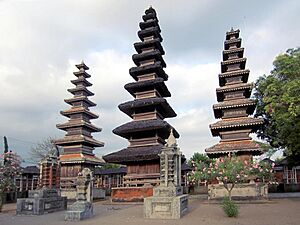
Most of the local Sasak people are Muslim. But before Islam arrived, Lombok was influenced by Hindu and Buddhist beliefs from Java. A small group of Balinese Hindus still live in Lombok. Islam may have come to Lombok in the 1600s through traders from Sumbawa. Other stories say it arrived earlier, in the 1500s. The Babad Lombok, an old manuscript, says that Sunan Prapen was sent to Lombok to spread Islam.
However, the new religion mixed with older beliefs. It often combined animist (belief in spirits) and Hindu-Buddhist ideas with Islam. A more traditional form of Islam became popular in the early 1900s.
Hinduism is followed by ethnic Balinese people and some Sasak people. All major Hindu ceremonies are celebrated in Lombok. Many villages on the island have a majority Hindu population. According to local stories, two of the oldest villages, Bayan and Sembalun, were founded by a prince from the Majapahit kingdom.
A small number of people practice Christianity. These include some ethnic Chinese and people who moved from Bali and East Nusa Tenggara. There are Roman Catholic churches and a Catholic hospital in Mataram. There are also two Buddhist temples near Tanjung, where about 800 Buddhists live.
Lombok also has a small Arab community. Their history goes back to early traders from Yemen. This community is mainly found in Ampenan, the old port of Mataram.
Some Sasak people follow a non-traditional Islamic group called Wektu Telu ("Three times"). They pray three times a day instead of the usual five. Their beliefs mix Islam with animism, Hinduism, and other spiritual ideas. There are also some Boda people who keep their original Sasak beliefs. These beliefs are not mixed with later Islamic influences.
Many Sasak people believe in spirits or ghosts. They use food and prayer to talk with spirits, including those of the dead. Traditional practices are still common. People use magic to protect against evil and sickness. They also use it to solve problems. Sometimes, people ask an experienced person to perform magic for them. They usually give money or gifts to these powerful practitioners, who are highly respected.
Tourism in Lombok

Tourism in Lombok began in the mid-1980s. People saw it as a less crowded option compared to Bali. At first, small, affordable bungalows appeared in places like the Gili islands and Kuta, Lombok. These were often owned by local businesses. Larger companies from outside Lombok started buying up beachfront land in areas like Senggigi.
In the 1990s, the Indonesian government started promoting tourism in Lombok. Organizations like the Lombok Tourism Development Corporation (LTDC) were created. They made plans for tourist facilities. Big hotels provided jobs for local people. Smaller businesses like restaurants and art shops also started, creating more jobs.
Tourism Challenges and Recovery
From 1997 to 2007, tourism faced many problems. Economic issues and political changes in Indonesia caused unrest. Some areas experienced violence. This made many countries warn their citizens about traveling to Indonesia.
Events like the Bali bombings in 2002 and 2005 also greatly affected tourism in Lombok. It took a long time for visitors to return. Only after 2007–2008, when most countries removed their travel warnings, did tourism start to recover to its previous levels.
Lombok Today as a Tourist Spot
Since 2010, tourism has grown quickly in Lombok. The number of visitors is now much higher than before 2000.
The Indonesian government actively promotes Lombok and nearby Sumbawa as top tourist spots after Bali. They aim for 1 million visitors each year. This has led to better roads and a new Lombok International Airport in the south. The Bali Tourism Development Corporation is also developing the Mandalika Resort Area in the south. This area stretches along 8 kilometers (5 miles) of sandy beach.
Tourism is a key part of Lombok's economy. The most developed tourist area is on the west coast, around Senggigi. This area has many hotels and resorts. The main tourist strip goes north from Mataram for about 30 kilometers (19 miles). It reaches Tanjung in the northwest, near Mount Rinjani. This area also includes the popular Gili Islands just offshore.
The Gili Islands are usually reached by boat from Bangsal or Teluk Nare. Many hotels there offer everything from budget stays to luxury resorts. Fast boat services now connect Bali directly to the Gili Islands.
Other popular places to visit include Mount Rinjani, Narmada Park, and Mayura Park. Kuta in the south is known for its quiet, white-sand beaches. It's becoming popular with surfers from around the world. The waves in South Lombok are considered some of the best.
The northwest coast near Tanjung has new luxury hotels and villas. These are close to the Gili islands and a new marina. These new places add to the existing five-star resorts and a large golf course.
Promoting Halal Tourism
In 2019, Lombok was rated highly as a halal tourist destination in Indonesia. The Indonesian government hopes to attract many Muslim travelers from around the world.
Halal tourism means that hotels, transport, and food follow Islamic principles. For example, halal hotels do not serve alcohol and provide prayer mats. This type of tourism aims to offer experiences that fit with Islamic beliefs.
Getting Around Lombok
Lombok International Airport is in southwest Lombok, near the city of Praya. It opened on October 1, 2011. This airport replaced the older Selaparang Airport near Ampenan. It is the only international airport in the West Nusa Tenggara province.
The old Selaparang Airport in Ampenan closed on September 30, 2011. It used to have flights to Java, Bali, and Sumbawa, and international flights to Singapore and Kuala Lumpur. The airport buildings are still there, but no planes use it for passengers.
Lembar Harbor in the southwest is a seaport. It has ferry services for cars and passengers. These ferries connect Lombok to other islands.
Labuhan Lombok ferry port on the east coast also has ferry services. These ferries take cars and passengers to Poto Tano on Sumbawa.
Travel Between Bali and Lombok
Flights from Ngurah Rai International Airport in Bali to Lombok International Airport take about 40 minutes. Lombok International Airport is about 1.5 hours drive from Senggigi, a main tourist area. It's also about 2 hours drive to Teluk Nara, where you can take a boat to the Gili Islands. Kuta in South Lombok is about 30 minutes away.
Public ferries travel between Padang Bai (Southeast Bali) and Lembar (Southwest Lombok) every hour. The trip takes at least 4–5 hours.
Fast boat services are also available from Bali. They mostly go to the Gili Islands. Some also go to the Lombok mainland. These boats arrive at places like Teluk Nare, Bangsal harbor, or Senggigi. The quality of these services can vary.
Festivals
A special event called the Nyale Festival, or Bau Nyale, happens between February and March. During this festival, people catch sea worms called nyale or wawo. A local legend says that these worms are the spirit of Princess Mandalika. She was a beautiful princess who jumped into the sea to avoid fighting suitors.
Images for kids
See also
 In Spanish: Lombok para niños
In Spanish: Lombok para niños


